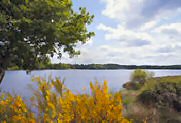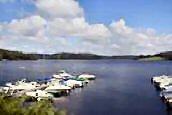LIMOUSIN

Situated in the heart of France, the Limousin boasts an unspoilt and idyllic environment. Because it's still relatively undiscovered property is still relatively inexpensive. The lush greenery, woodland, lakes and rivers create the perfect setting for a quiet, relaxed life.
Made up of three departments, the Haute-Vienne, Creuse and the Correze and to the west of the Massif Centrale, the Limousin takes its name from a Celtic tribe called the Lemouices, which occupied the area at the time of the Gauls
The Limousin's capital city is Limoges, which arose from a Roman settlement at the crossing of the Bordeaux & Lyon roads. Originally called Augustoritum, after the emperor Augustus, the area's early riches came from both tin and lead. Over the centuries and until recently, Gold, Copper, Quartz and Uranium have all been mined. The most important discovery, though, was that of kaolin - a fine and malleable white clay, discovered in the eighteenth Century and used to make the world renowned Limoges porcelain.

The Limousin suffers from acidic soil and so thrives principally on livestock farming and is famed for its Vaches Limousin, a dark reddy/brown cow which produces fine meat and leather. The province still has a small population, although it is growing, attracting more businesses whilst traditional sectors such as porcelain and tapestry continue to thrive. The space and fantastic scenery attract many holiday makers, many who have settled permanently, seduced by the abundant countryside, fresh air and the huge number of spectacular lakes and rivers.
The region, relatively undiscovered even a few years ago, is attracting more and more foreign buyers - a large proportion of whom are British. Although property prices have risen accordingly the area is still considered by many to offer the best value in France and there are still many little known sectors bursting with unspoilt charm.
The 25 biggest towns and Cities
Limoges, Brive-la-Gaillarde, Tulle, Gueret, Ussel, Saint-Junien, Panazol, Isle,
Saint-Yriex-la-Perche, Couzeix, Malemort-sur-Correze, Le palais-sur-Vienne,
Aixe-sur-Vienne, La Souterrainne, Feytiat, Ambazzac, Saint-Leonard-de-Noblat,
Aubusson, Bellac, Condat-sur-Vienne, Egletons, Saint-Pantaleon-de-Larche,
Rochechouart, Rilhac-Rancon, Bort-les-Orgues
The Haute Vienne has it
all, especially property........Lush green rolling countryside, hills and
valleys, an abundance of woodland, wildlife and lakes and rivers which stretch
out westwards from the Massif Centrale range of mountains. The area receives
plentiful rainfall as clouds coming off the Atlantic hit their first
obstruction. The climate is one of long hot summers interspersed with short but
sometimes violent thunderstorms, and short cold winters.
The capital of the Haute-Vienne and also the Limousin is Limoges, the liveliest
town, with a cosmopolitan feel to it, packed with boutiques, bars and
restaurants. It is also home to Limoges University and has a lot to offer the
prospective buyer. Limoges has good travel links to the rest of France and the
UK, with its train station, major road links and its airport (Ryan Air fly
direct to London, Stansted).
There are many towns and small villages within a 15 minute drive of Limoges with
a mixture of property available from a traditional farm house through to a
modern house with garden. If you are looking for a renovation project then for
something with the potential for 4+ bedrooms you should expect to be paying
between £60000 - £100,000, depending on location and size of renovation project.
Other towns of interest in the Haute Vienne include;
Bellac
 Property in and
around Bellac remain incredibly cheap. Bellac is a historic market town
that boasts a 12th Century church, a 16th Century town hall, a museum and
a viaduct over the river that winds through the town. There is a good mix
of shops, bars and restaurants and the market is a good place to buy food
and wine direct from the locals. It has a population of a little over 5000
and is close by to lac St Pardoux where numerous water sports and
activities can be enjoyed.
Property in and
around Bellac remain incredibly cheap. Bellac is a historic market town
that boasts a 12th Century church, a 16th Century town hall, a museum and
a viaduct over the river that winds through the town. There is a good mix
of shops, bars and restaurants and the market is a good place to buy food
and wine direct from the locals. It has a population of a little over 5000
and is close by to lac St Pardoux where numerous water sports and
activities can be enjoyed.
Le Dorat
Le Dorat is an ancient town, with fine examples of Romanesque architecture,
especially the 11th Century Collegiate of Saint-Pierre. There is a small
campsite in the town. There is plenty to do all year round with Horse Racing
events in June, July and August; a National Horse Show in September; Sound and
Light show; Craft days; Christmas Market as well as concerts, tennis, cinema,
fishing, sailing and windsurfing.
Founded during the late middle ages and surrounded by ramparts. Today you can still admire the XII century church of Notre-Dame and period architecture amongst the winding streets and banks of the River Vincou. Birth place of poet and playwright Jean Giraudoux, Bellac’s lively annual National Festival (June/July) is dedicated to theatre, dance and music, notably jazz.
Mézières-sur-Issoire
lies on the border of the Limousin and Charente regions, offering superb
walking, fishing, cycling and relaxation. This is a haven for artists and an
ideal location for exploring the many towns and villages with architecture
dating back to medieval times. Discover the local crafts of yesterday and
today and enjoy the food and wine and specialties of the region.
Lakes and Water sports
— A variety of sports including swimming, sailing, canoeing, windsurfing, as
well as horse riding, at St Pardoux to the north of Limoges, and Lac de
Vassivière (one of the largest lakes in France) to the east.

Fishing
“Haute Vienne– land of a thousand lakes”. River & Lake fishing available all
year round.
Golf—
18 hole courses
at St Junien and Limoges offer golfers of all levels challenging play in
beautiful surroundings.
DEPTS IN REGION
These departments are in this region, click on the department name to explore.
Correze
Creuse
Haute Vienne




